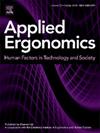Experience of use, usability and psychosocial impact of robotic and virtual reality technology in neuromotor rehabilitation: A mixed-method triangulation analysis of patients' and their therapists’ perspective
IF 3.4
2区 工程技术
Q2 ENGINEERING, INDUSTRIAL
引用次数: 0
Abstract
Robotics and Virtual Reality (VR) have shown promise in rehabilitation programs, but more integrated technology evaluations are essential to promote patient engagement and outcomes. This study assessed technology experience of use, usability, and psychosocial impact in neuromotor rehabilitation, by accounting both patients' (n = 29) and their therapists' (n = 13) view. A mixed-method convergent parallel design with a nested triangulation protocol was adopted to analyze participants’ perspectives and further identify agreements and discrepancies. Positive perceptions of technology experience of use, usability, and psychosocial impact were reported by patients along with significant correlations between technology use and perceived effectiveness. Therapists noted acceptable usability with some device-specific variations. From qualitative data, key themes were identified (i.e., "Learnability," "Engagement," "Implementation", "Barriers") and areas for improvement were highlighted for future deployment. Finally, triangulation showed broad agreement among participants. Findings emphasize the need for integrating different user perspective when evaluating rehabilitation technologies and underscore their potential to enhance rehabilitation outcomes.
机器人和虚拟现实技术在神经运动康复中的使用经验、可用性和心理社会影响:患者及其治疗师视角的混合方法三角分析
机器人技术和虚拟现实(VR)在康复项目中已经显示出前景,但要提高患者的参与度和效果,更综合的技术评估是必不可少的。本研究通过考虑患者(n = 29)和治疗师(n = 13)的观点,评估了神经运动康复中的技术使用体验、可用性和心理社会影响。采用嵌套三角协议的混合方法收敛并行设计来分析参与者的观点,并进一步识别一致和差异。患者报告了对技术使用体验、可用性和心理社会影响的积极感知,以及技术使用与感知有效性之间的显著相关性。治疗师注意到一些设备特定变化的可接受的可用性。从定性数据中,确定了关键主题(即,“可学习性”、“参与”、“实施”、“障碍”),并强调了未来部署中需要改进的领域。最后,三角测量显示了参与者之间的广泛共识。研究结果强调,在评估康复技术时,需要整合不同的用户视角,并强调其提高康复效果的潜力。
本文章由计算机程序翻译,如有差异,请以英文原文为准。
求助全文
约1分钟内获得全文
求助全文
来源期刊

Applied Ergonomics
工程技术-工程:工业
CiteScore
7.50
自引率
9.40%
发文量
248
审稿时长
53 days
期刊介绍:
Applied Ergonomics is aimed at ergonomists and all those interested in applying ergonomics/human factors in the design, planning and management of technical and social systems at work or leisure. Readership is truly international with subscribers in over 50 countries. Professionals for whom Applied Ergonomics is of interest include: ergonomists, designers, industrial engineers, health and safety specialists, systems engineers, design engineers, organizational psychologists, occupational health specialists and human-computer interaction specialists.
 求助内容:
求助内容: 应助结果提醒方式:
应助结果提醒方式:


